In one of the conferences I recently attended, I bumped onto Head of Transaction banking in a leading bank in the middle east region. He being a Cash Management Practitioner, we immediately connected and started exchanging notes. During discussion he quoted an example of how onboarding a large telco as a customer, took them 6 months. Most of the time was spent to customize certain processes & data formats for payment initiations, mandate management, direct debits, status updates, reporting and reconciliation.
This incident set me thinking about corporate banking channels. Though 6 months was really long time, in most of the cases, to customize data formats for specific requirements, takes about 2-3 months, depending on the complexity and availability of all requisite parties. Even for corporate treasurers, new banking relationship introduces new project on their side. And if the corporate is MNC, these problems could be multi-fold.
If we look at Corporate Banking Channels, Internet Banking is the most common channel used by corporate customers for interacting with their Banks. Some large Financial Institutions also offer C2B i.e. Corporate to Bank or Direct Banking channel that allows the corporate customers to integrate their ERP systems directly with their Bank. But such C2B solutions are offered by very few banks and that to only for their large corporate customers, while others are left with no choice but to use Corporate Internet Banking.
From the bank’s point of view, Corporate Internet Banking is one monolithic application which cannot be customized for each corporate customer. At the same time, C2B Channel is an expensive proposition and requires technology maturity at the corporate end. Hence the banks are in catch 22 situation.
How do we cater to requirements of corporate customers without complicating or over engineering the corporate internet banking application?
One obvious solution is to develop the common data exchange formats. However, one size doesn’t fit all. With variety of ERP systems and specific requirements of each corporate, standardized formats cannot cater to their needs.
Another possible solution is to localize the customizations for each corporate outside Corporate Internet Banking Application. In order to localize the customizations, the banks should look at an intermediate application which will take care of the customized data formats, reporting as well as industry / segment / corporate specific customizations.
This intermediate application should provide:
- Data Transformation: It should provide ability to the bank to configure the data formats for each corporate customer. It should cover the data transformation starting from standardized data conversion routines for each ERP / Accounting application (and their specific versions) to more specific data conversion for each corporate customer.
- Library of Functions: Specific data enrichment’s required for industry / segment / specific corporate should be developed as functions and be made available as part of standard library which can be reused during data transformation.
- Data Validation Framework: Centralized data validation framework which will validate the data for each product and product processor.
- Secure Data Transportation: Should support various data transmission mechanism for back-n-forth communication between the corporate and bank.
- Straight Through Processing: Ability to expose the underlined services as APIs which can be directly consumed by the Corporate Customer to initiate transactions as well as receive status updates.
Such application will help the bank to declutter their corporate internet banking, reduce their dependencies on multiple parties to customize the solution required for each corporate and thereby reduce the turn-around-time to on-board / service the corporate customers.
